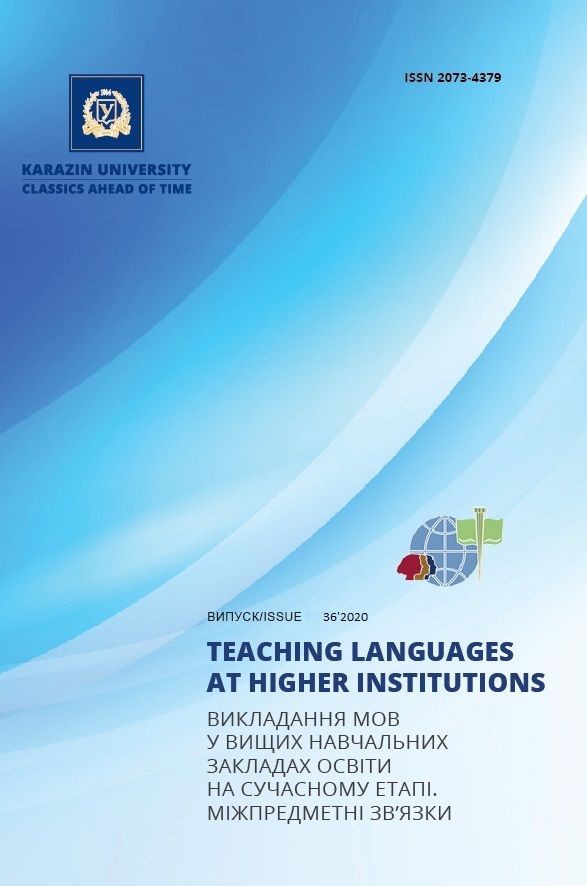Linguocommunicative competence of the linguist teacher: ethnospecificity of anthroponyms’ functioning in the learning and pedagogical discourse of the educational space
Abstract
The article deals with the linguocommunicative competence of a language teacher in relation to a professionally correct contact with a non-native student in the class of Russian / Ukrainian as a foreign language. The focus is on the form of addressing the student in view of ethnospecificity, i.e. using the full personal name and taking into account the number and functions of its constituents, their legally fixed sequence and traditions of naming. The purpose of the research is to draw the attention of language teachers to the ethnospecificity of the anthroponymic formula, functional and socio-cultural significance of its components, to its connection with the national concept of personality and the linguistic picture of the world, to its special place in the process of adaptation and acculturation of foreign students to a different educational of space. The authors identify, describe and analyze the functions of these constituents in the anthroponymic formulas of numerous ethnic groups that are represented in the university educational space (Arabic and Indian students). The article reveals their differences from the modern traditional anthroponymic formulas for the social identification of personality in Ukraine. The authors analyze the correspondence of such a form of address to the requirements of intercultural communication and the limits, behind which the student begins to feel discomfort and even could have a cultural shock. The relationship of anthroponymicons with the linguistic picture of the world, national concepts of personality and mentality of each ethnic group have been noted as well. The modern general trends of the process of changing the world anthroponymicon, lexical and grammatical educational topics in the language of the specialty, during the study of which students need knowledge of practical comparative anthroponymy, have been named. The article uses the concept of ethos to determine the hierarchy of communication values, which is reflected in the sequence of components of such a formula and markers of a personal name.
Downloads
References
Alekseenko, T.N., Vasetskaia, L.I. and Kushnir, I.M. (2019). Profesijne spilkuvannya: likar-hvory: posibnik dlya inozemnyh studentiv-medikiv (anglomovnoi formy navchannja) [Professional communication: doctor-patient. Textbook for foreign medical students (English mediun)]. Kharkiv: V.N. Karazin KHNU, pp. 4–7 [in Ukrainian].
Dospanova, D.U. (2017). Antroponimy i nekotorye aspekty ikh izuchenija [Antroponymes and some aspects of their study]. Molodoj uchenyj [Young scientist ], 14, pp. 712–714 [in Russian].
Encyklopediya suchasnoyi Ukrayiny [Encyclopedia of the modern Ukraine]. Availiable at: http://esu.com.ua/ search_articles.php? id=43065 www.nas.gov.ua›series›3_Zheleznyak12_ [Accessed 10 January 2020] [in Ukranian].
Gabidullina, A.R. (2009). Ponjatie “pedagogicheskij discurs” v nauchnoi literature. Uchebno-pedagogicheskij discurs; kategorialnaja structura i zhanrovoe svoeobrazie [Concept of “pedagogical discourse” in scientific literature. Educational – pedagogical discourse: category structure and genre distinctive quality]. Doctor’s thesis. Donetsk [in Russian].
Gnatyuk, L. (2014). Verbalni i neverbalni vyiavy etnospestifiky v mizhkulturnomu mizhosobystisnomu spilkuvanni [Verbal and nonverbal indexes ethno specifics in intercultural individual communication]. Naukovi Zapysky Berdianskogo derzhavnoho pedagogichnoho universitetu [Scientific Notes of the Berdyansk Sovereign Pedagogical University], pp.100–109 [in Ukrainian].
Ivanova, T.A. and Chernenko, I.I. (2013). Fizicheskie lica kak uchastniki grazhdanskih pravootnoshenij. Russkij jazyk juristam: posobie po nauchnomu stilju rechi dlja studentov-inostrancev 2 kursa [Physical persons as participants of civil law relations Russian language for lawyers: testbook in scientific style for 2-nd year foreign students]. Kharkiv: SMIT company, pp. 42–60 [in Russian].
Kovurshina, N.B. (2001). Imena sobstvennye v culture arabov [Proper nouns in the Arabic culture]. Vestnik RUDN [Bulletin of the RUDN University]. Ser. Literary criticism, journalism, 5, pp. 63–66 [in Russian].
Kuplevastka, L.O. (2019). Profesiyna lingvakomunikativna kompetentnist vykladacha v konteksti mizhkulturnoi komunikacii [Professional linguacommunicative teacher’s competence in the context of intercultural communication]. Vykladannia mov u vyshchykh navchalnykh zakladakh osvity na suchasnomu etapi. Mizhpredmetni zviazky [Teaching Languages at Higher Institutions]. Kharkiv: V.N. Karazin Kharkiv National University, 34, pp. 79–92 [in Ukrainian]. DOI: https://doi.org/ 10.26565/2073-4379-2019-34-06.
Kuplevastka, L.O. (2019). Skladnyky imidzhu vykladacha vyschoi shkoly v konteksti mizhkulturnoi komunikastii [Parts of teacher’s image in the context on intercultural communication]. Mizhculturna komunikaciya v universitetskomu osvitnomu prostori [Intercultural communication in the unified versatility]. Kharkiv, pp. 193–208 [in Ukrainian].
Kuplevastka, L.O. and Manivska, T.E. (2016). Osoblivosti lingvokulturnoy adaptacii indijskih studentov u vyshhyh navchalnyh zakladah Ukrayiny v konteksti mizhkulturnoyi komunikaciyi [Peculiarities of linguacultural adaptation of Indian students at high school of Ukraine in the context of intercultural communication]. Vykladannia mov u vyshchykh navchalnykh zakladakh osvity na suchasnomu etapi. Mizhpredmetni zviazky [Teaching Languages at Higher Institutions]. Kharkiv: V.N. Karazin Kharkiv National University, 29, pp. 55–69 [in Ukrainian].
Madieva, G.B. and Suprun, V.I. Antroponimy kak sredstvo vyrazhenija nacionalnoj kultury [Antroponymes as means of expression of national culture]. Availiable at: https://cyberleninka.ru/journal/n/izvestiya-volgogradskogo-gosudarstvennogo-pedagogicheskogo-universiteta [Accessed 23 December 2019] [in Russian].
Manakin, V.M. (2012). Mova i mizhkulturna komunikaciya [Language and intercultural communication]. Kyiv: “Akademiia” [in Ukrainian].
Oberg, R. (1960). Culture shock: Adjustment to new cultural environments. Practical Antropology. V. 7, pp. 177–182 [in English].
Obzor jazykovogo raznoobrazija Indii [Overview of the linguistic diversity of India]. Availiable at: https://linguapedia.info/articles/obzor-yazykovogo-raznoobraziya-indii.html [Accessed 25 December 2019] [in Russian].
Richrd, Ishida. Personal names around the world. Availiable at: https://www.w3.org/International/questions/qa-personal-names [Accessed 12 February 2020] [in English].
Ufimsteva, A.A. (1988). Rol leksiki v poznanii chelovekom dejstvitelnosti v formirovanii jazykovoj kartiny mira [Role of vocabulary in the cognition of the reality in the process of formation of the language world picture]. Rol chelovecheskogo faktora v yazyke. Jazyk i kartina mira [The role of the human factor in language. Language and picture of the world]. Moscow: Nauka, pp. 108–140 [in Russian].
Van Deik, T.A. (1998). K opredeleniju discursa [On discourse definition]. Leningrad: Sage publication [in Russian].
Vorontsova, I.I. and Chaplin, S.G. (2014). Osobennosti obrazovanija antroponimov (sravnitelnyj analiz russkoj i anglijskoj tradicyj) [Peculiarities of antroponyms’ formation (comparative analysis of Russian and English traditions)]. Novyi filologicheskiy vestnik. Perevodovedenie [New philological bulletin. Translation studies], 3(30), pp. 136–144 [in Russian].
Zhang Yu, Ian Huei and Solovjova, M. Nacionalno-kulturnaja semantika russkih i kitaiskih antroponimov [National cultural semantics of the Russian and Chinese antroponymes]. Availiable at: https:// cyberleninka.ru/article/n/natsionalno-kulturnaya-semantika-russkih-i-kitayskih-antroponimov [Accessed 02 February 2020] [in Russian].

